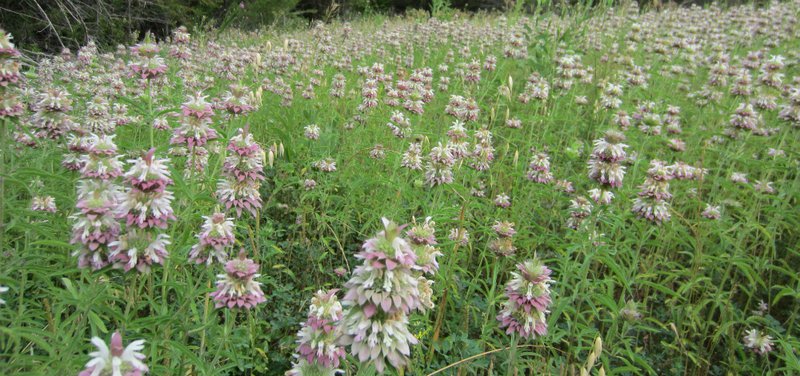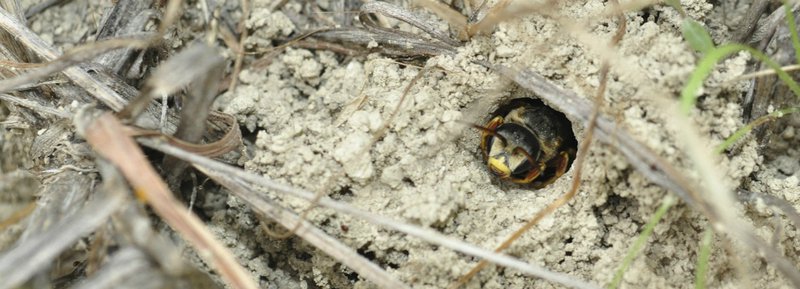Native Bee Needs — Augment Resources
A survey of your property, over the course of a growing season, may reveal deficits in available native flowering plants and/or nesting sites. There are steps you can take to augment these resources. Increasing the diversity of native flowering plants on your property is probably one of the more rewarding strategies. Increasing native plant diversity will also provide additional host plant resources for butterflies and moths.
Nectar and Pollen
Augmenting floral diversity with plants native to Texas is your best choice. Native plant species have coevolved with native bees over time, and they are also better adapted to the state's climate. For a list of native plants attractive to native bees adapted to your region of Texas see the Ecoregional Plant Lists. These plants will also support scores of other native flower-visitors including beetles, butterflies, flies, hummingbirds, and wasps.
Incorporate native annual and perennial herbaceous plants as well as flowering shrubs and trees where possible to provide a succession of blooms from early spring, through summer, and into fall. Robust sources of nectar and pollen during these three periods will meet the needs of a wide range of native bees and other flower-visitors. A good starting point is ensuring that you have at least three plant species flowering in each season for a total of nine over the growing season. Once that minimum is met you can then work to further increase native plant diversity over time. You can also start with a more species-rich seed mix if you desire.

Exactly how you increase native plant diversity at your site will depend upon the current condition of the area you wish to manage. Properties with low floral diversity may benefit from over-seeding with a native seed mix including forbs geared to native pollinator needs. If over-seeding a site, emphasize seeds from local sources. Obtaining an as-local-as-possible seed mix is not only helpful for establishment success but also aids in the protection of existing local plant gene pools. Within the ecologically and environmentally diverse state of Texas, local seed may mean seeds sourced from the same ecoregion as the target planting site.
Areas heavily invaded by non-native plants may require relatively intensive efforts, especially with regards to site preparation and weed control, to convert your property to a more native pollinator-friendly state. Conversely, your property may be in relatively good shape and simply require adjustments to management practices to increase and perpetuate resources already found on-site.
If the expense of restoring an entire site through re-seeding is too great, smaller "native pollinator plots" can be installed across a property and seeded with a high-quality native plant species mix. Such plots can be fenced to protect herbaceous and woody flowering plants from surrounding management practices, harmful invasive animals (e.g. feral hogs), or grazing herbivores. See Establishing Pollinator Meadows from Seed (The Xerces Society for Invertebrate Conservation) for more information.
Nest Sites
The second piece of the puzzle in conserving native bee populations is increasing available nesting habitat. The specific conditions required by most ground-nesting solitary bees are not well known. Some species nest in the ground at the base of plants and others prefer smooth packed bare ground. Different species of native ground-nesting bees prefer different soil conditions, although research suggests that many ground nesting bees prefer sandy, loamy sand or sandy loam soils. Landowners can create conditions suitable to a variety of species by maximizing undisturbed areas of semi-bare ground.

In contrast to ground-nesting bees, other species such as many carpenter bees, leafcutter bees, and mason bees nest in cavities in dead wood or the pithy stems of herbaceous plants. Creating piles of dead woody vegetation from brush clearing can provide suitable nesting habitat for several native bees and a number of other wildlife species. If you lack standing dead trees, girdling select trees is another option for creating dead wood habitat for native bees, woodpeckers, and other species. Remember to consider the tree's proximity to areas of human activity, roads, and structures, before girdling it.
Pesticide Use
Pesticides are detrimental to a healthy community of native insect pollinators. Insecticides may not only kill insect pollinators, but sub-lethal doses can affect their foraging and nesting behaviors. In general, while pesticide labels may list hazards to honey bees, potential dangers to native bees are often not listed. For example, many native bees are much smaller in size than honey bees and are negatively affected at lower doses. Also, honey bee colonies may be covered or moved from a field, whereas wild natives will continue to forage and nest in sprayed areas. Lastly, because most native bees are solitary, there is the potential for larger ramifications of a single mortality event. If a worker honey bee or bumble bee dies, then the colony can continue. If a solitary bee dies, then her entire reproductive output is lost. For these and other reasons, the use of pesticides in areas managed for native insect pollinators should be avoided. Drift from pesticides applied on lands with alternate uses should also be minimized. See Xerces Model Policy to Protect Pollinators from Harmful Pesticide Exposures for more information.